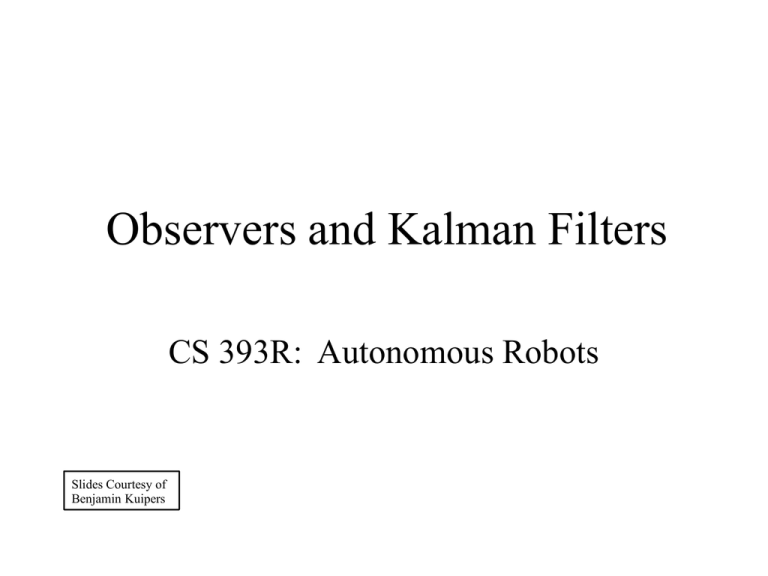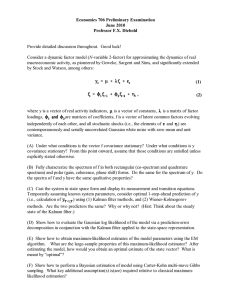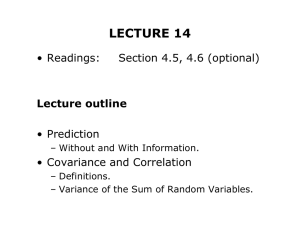Observers and Kalman Filters CS 393R: Autonomous Robots Slides Courtesy of
advertisement

Observers and Kalman Filters CS 393R: Autonomous Robots Slides Courtesy of Benjamin Kuipers Good Afternoon Colleagues • Are there any questions? Stochastic Models of an Uncertain World xÝ F(x,u) xÝ F(x,u,1) y G(x) y G(x,2 ) • Actions are uncertain. • Observations are uncertain. • i ~ N(0,i) are random variables Observers xÝ F(x,u,1 ) y G(x,2 ) • The state x is unobservable. • The sense vector y provides noisy information about x. ˆ Obs(y) is a process that uses • An observer x sensory history to estimate x. • Then a control law can be written u Hi (xˆ ) Kalman Filter: Optimal Observer xÝ F(x,u,1 ) y G(x,2 ) 1 u x y 2 xˆ Estimates and Uncertainty • Conditional probability density function Gaussian (Normal) Distribution • Completely described by N(, 2) – Mean – Standard deviation , variance 2 1 2 (x )2 / 2 2 e The Central Limit Theorem • The sum of many random variables – with the same mean, but – with arbitrary conditional density functions, converges to a Gaussian density function. • If a model omits many small unmodeled effects, then the resulting error should converge to a Gaussian density function. Illustrating the Central Limit Thm – Add 1, 2, 3, 4 variables from the same distribution. Detecting Modeling Error • Every model is incomplete. – If the omitted factors are all small, the resulting errors should add up to a Gaussian. • If the error between a model and the data is not Gaussian, – Then some omitted factor is not small. – One should find the dominant source of error and add it to the model. Estimating a Value • Suppose there is a constant value x. – Distance to wall; angle to wall; etc. • At time t1, observe value z1 with variance • The optimal estimate is xˆ (t1) z1 with 2 variance 1 2 1 A Second Observation • At time t2, observe value z2 with variance 2 2 Merged Evidence Update Mean and Variance • Weighted average of estimates. xˆ (t 2) Az1 Bz2 A B 1 • The weights come from the variances. – Smaller variance = more certainty 2 2 ˆx (t 2 ) 2 2 2 z1 2 1 2 z2 1 2 1 2 1 1 1 2 2 2 (t 2 ) 1 2 From Weighted Average to Predictor-Corrector • Weighted average: xˆ (t2) Az1 Bz2 (1 K)z1 Kz2 • Predictor-corrector: xˆ (t 2) z1 K(z2 z1) xˆ (t1) K(z2 xˆ (t1)) – This version can be applied “recursively”. Predictor-Corrector • Update best estimate given new data xˆ (t 2) xˆ(t1) K(t 2)(z2 xˆ (t1)) • Update variance: 12 K(t 2 ) 2 2 1 2 (t 2 ) (t1 ) K(t2 ) (t1 ) 2 2 2 (1 K(t2 )) (t1 ) 2 Static to Dynamic • Now suppose x changes according to xÝ F(x,u,) u (N (0, )) Dynamic Prediction 2 ˆ • At t2 we know x (t 2 ) (t 2 ) • At t3 after the change, before an observation. 3 xˆ (t ) xˆ (t2 ) u[t3 t 2 ] 3 (t ) (t2 ) [t3 t2 ] 2 2 2 • Next, we correct this prediction with the observation at time t3. Dynamic Correction • At time t3 we observe z3 with variance • Combine prediction with observation. 3 3 xˆ (t 3 ) xˆ(t ) K(t3 )(z3 xˆ (t )) 3 (t 3 ) (1 K(t 3 )) (t ) 2 2 (t ) K(t 3 ) 2 2 (t3 ) 3 2 3 2 3 Qualitative Properties 3 3 xˆ (t 3 ) xˆ(t ) K(t3 )(z3 xˆ (t )) 2 (t3 ) K(t 3 ) 2 2 (t3 ) 3 • Suppose measurement noise 2 3 is large. – Then K(t3) approaches 0, and the measurement will be mostly ignored. 3 • Suppose prediction noise (t ) is large. 2 – Then K(t3) approaches 1, and the measurement will dominate the estimate. Kalman Filter • Takes a stream of observations, and a dynamical model. • At each step, a weighted average between – prediction from the dynamical model – correction from the observation. • The Kalman gain K(t) is the weighting, 2 2 – based on the variances (t) and 2 • With time, K(t) and (t) tend to stabilize. Simplifications • We have only discussed a one-dimensional system. – Most applications are higher dimensional. • We have assumed the state variable is observable. – In general, sense data give indirect evidence. xÝ F(x,u,1) u 1 z G(x,2) x 2 • We will discuss the more complex case next. Up To Higher Dimensions • Our previous Kalman Filter discussion was of a simple one-dimensional model. • Now we go up to higher dimensions: n x – State vector: m – Sense vector: z l – Motor vector: u • First, a little statistics. Expectations • Let x be a random variable. • The expected value E[x] is the mean: N 1 E[x] x p(x) dx x x i N 1 – The probability-weighted mean of all possible values. The sample mean approaches it. • Expected value of a vector x is by component. T E[x] x [x1, x n ] Variance and Covariance • The variance is E[ (x-E[x])2 ] N 1 2 2 2 E[(x x ) ] (x i x ) N 1 • Covariance matrix is E[ (x-E[x])(x-E[x])T ] 1 Cij N N (x ik x i )(x jk x j ) k 1 – Divide by N1 to make the sample variance an unbiased estimator for the population variance. Covariance Matrix • Along the diagonal, Cii are variances. • Off-diagonal Cij are essentially correlations. C1,1 12 C1,2 2 C2,2 2 C2,1 CN ,1 2 N C1,N CN ,N Independent Variation • x and y are Gaussian random variables (N=100) • Generated with x=1 y=3 • Covariance matrix: 0.90 0.44 Cxy 0.44 8.82 Dependent Variation • c and d are random variables. • Generated with c=x+y d=x-y • Covariance matrix: 10.62 7.93 Ccd 7.93 8.84 Discrete Kalman Filter • Estimate the state x n of a linear stochastic difference equation x k Ax k1 Buk1 wk1 – process noise w is drawn from N(0,Q), with covariance matrix Q. • with a measurement z m zk Hx k vk – measurement noise v is drawn from N(0,R), with covariance matrix R. • A, Q are nn. B is nl. R is mm. H is mn. Estimates and Errors n ˆ • x k is the estimated state at time-step k. n ˆ • x k after prediction, before observation. ˆ e x x • Errors: k k k e k x k xˆ k • Error covariance matrices: k k T k P E[e e ] Pk E[e k eTk ] • Kalman Filter’s task is to update xˆ k Pk Time Update (Predictor) • Update expected value of x ˆx k Axˆ k1 Buk1 • Update error covariance matrix P T Pk APk 1A Q • Previous statements were simplified versions of the same idea: 3 3 xˆ (t ) xˆ (t2 ) u[t3 t 2 ] (t ) (t2 ) [t3 t2 ] 2 2 2 Measurement Update (Corrector) • Update expected value k k xˆ k xˆ K k (z k Hxˆ ) ˆ – innovation is z k Hx k • Update error covariance matrix k Pk (I K kH) P • Compare with previous form 3 3 xˆ (t 3 ) xˆ(t ) K(t3 )(z3 xˆ (t )) 2 2 (t 3 ) (1 K(t 3 )) (t3 ) The Kalman Gain • The optimal Kalman gain Kk is T T 1 K k Pk H (HPk H R) k T PH T HPk H R • Compare with previous form (t ) K(t 3 ) 2 2 (t3 ) 3 2 3 Extended Kalman Filter • Suppose the state-evolution and measurement equations are non-linear: x k f (x k1,uk1) wk1 zk h(x k ) vk – process noise w is drawn from N(0,Q), with covariance matrix Q. – measurement noise v is drawn from N(0,R), with covariance matrix R. The Jacobian Matrix • For a scalar function y=f(x), y f (x)x • For a vector function y=f(x), f1 y1 x (x) 1 y Jx f y n n (x) x1 f1 (x) x x n 1 f n (x) x n x n Linearize the Non-Linear • Let A be the Jacobian of f with respect to x. f i A ij (x k1,uk1 ) x j • Let H be the Jacobian of h with respect to x. hi H ij (x k ) x j • Then the Kalman Filter equations are almost the same as before! EKF Update Equations • Predictor step: ˆx k f ( xˆ k1,uk1 ) k P APk 1A Q T k k 1 • Kalman gain: K k P H (HP H R) • Corrector step: T T ˆx k xˆ k K k (z k h(xˆ k )) k Pk (I K kH) P





